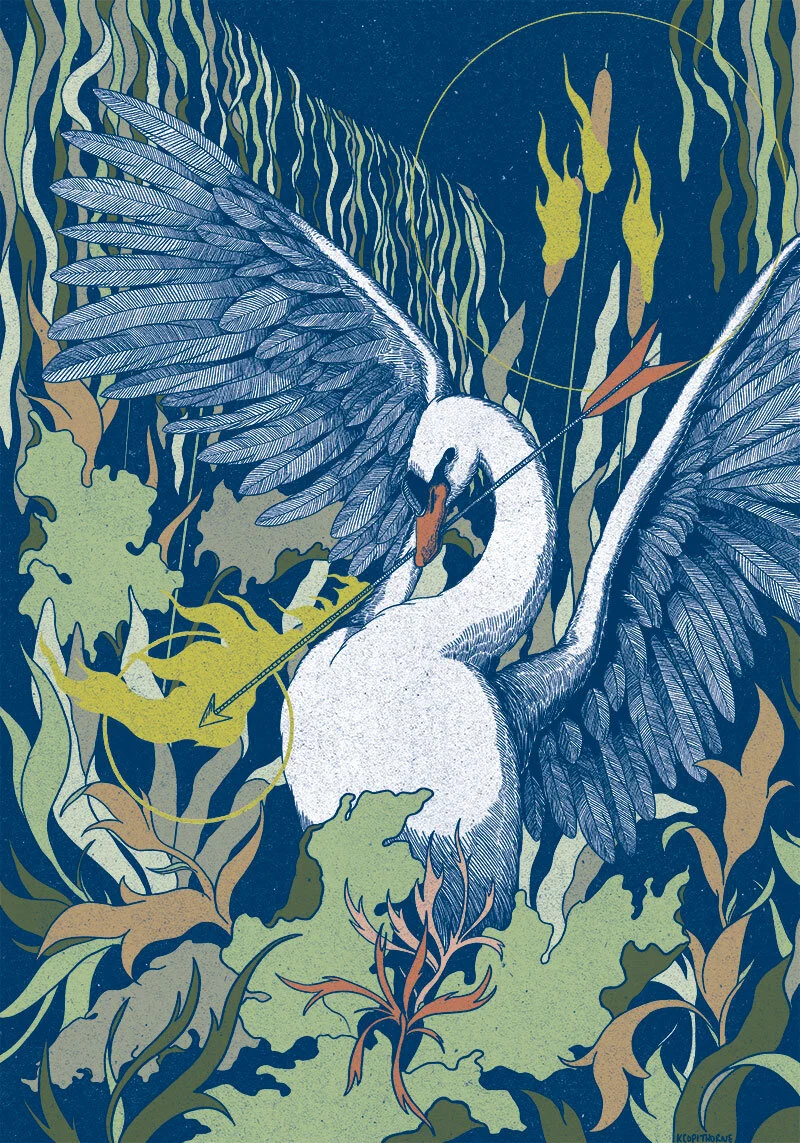Sanctae Hildegardis
Kaitlynn Copithorne is a Calagary, Canada-based illustrator and a regular contributor to Cunning Folk. We instantly fell in love with her distinctive aesthetic and her depictions of animals and folklore. You can see her work throughout our website, and illustrating Zoe Gilbert’s short story The Wild Hunt in our first print issue. We have plenty of exciting things planned in future together, and Kaitlynn is definitely one to watch. Normally Kaitlynn’s images speak for her, but we had a brief chat with her about her inspirations.
Cunning Folk Tell us about your own practice, both creative and magical.
Kaitlynn Copithorne I am an illustrator and visual artist working in digital, printmaking, and painting mediums. I like my work to tell stories. Magically my practice would probably fall under the “traditional witchcraft” definition, and since I deal mainly with land wights and the energy in the landscape, depends heavily on where I am practicing.
CF How do you find ideas? Who or what inspires you?
KC Most of my inspiration comes from nature, folklore, and mythology, particularly creation and etiological myths. I grew up quite isolated on a ranch in rural Canada and spent a lot of time by myself in the forests and fields, and so I think the natural world just became my primary knowledge base for understanding the world. I’m a big collector of folklore as well and that is definitely where my mind tends to go first when starting a new project.
CF What is your dream commission?
KC Right now I think my dream commission would be an oracle or tarot deck. I am very interested in the challenge of creating a visual language for a body of work that large while keeping it all cohesive.
CF What initially drew you to folklore and witchcraft?
KC Initially I was drawn to it through movies, especially The Craft. I was definitely an outsider and I saw characters I identified with empowering themselves through witchcraft and wanted that for myself. As I learned more about cunning people and witch lore I realized that their practices were actually not that different from my own “superstitions” as I called them that I developed growing up on the ranch.
CF You have done quite a lot for cunning folk. What about this project appealed to you?
KC I was drawn to Cunning Folk because it combined so many of my interests (mythology, folklore, witchcraft, nature) in one platform. I’m always looking for witchcraft and folklore themed publications and zines, and Cunning Folk struck me as contemporary and less academic than other publications I subscribe to, and I mean that in a good way. It handles these subjects on a very personal level, and I find it very fulfilling to myself creatively and magically to read about other people’s personal practices.
CF Pertinent to this current issue, do you think we are going through a period of re-enchantment?
KC Definitely. I think enchantment works as a cycle, and we are currently at the point where widespread dis-enchantment begins to breed re-enchantment on a collective level. Speaking specifically from a North American perspective, we are realizing that the colonial systems in place supposedly to keep us safe, healthy, and fulfilled do not in fact do any of those things very well, if at all, for a vast majority of us. Even more distressing is the dawning realization that this system isn’t failing us because it’s broken, it’s functioning exactly as it was designed to, and does not care about anyone falling through its cracks. And so, like cunning folk of the past, when the institutions won’t empower us, we seek to empower ourselves. To me, the fact that we keep circling back to magic when everything else has let us down speaks to how deeply embedded it is in us. When our power has been taken away from us we inevitably turn back to ourselves to replenish it, and there we find magic waiting for us.
The Wild Hunt Spread
Illustration spreads from in-progress project The Moon Being Full.
Swan Brings the Holy Fire
Currently available in collection at Glo’Art Centre, Belgium.
Block Heater Music Festival 2020
All images © Kaitlynn Copithorne






